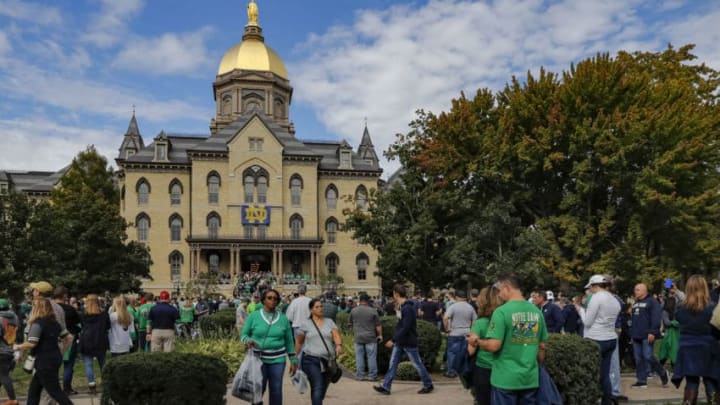Notre Dame football is proud to remember the first black student-athlete to earn a monogram award at the school, Wayne Edmonds.
It’s no secret that the end of segregation in sports was a long, drawn out one. While Jackie Robinson breaking the color barrier in 1947 for baseball, the Red Sox wouldn’t integrate until 1959 when Pumpsie Green took the field at Fenway. College football was no different.
George Jewett of Michigan is said to be the first black college football player. That was in 1890. With that being said, Texas and Arkansas were still playing an all-white game of the century in 1969. In the meantime, Iowa State’s Jack Trice was killed during a game, Johnny Bright was assaulted in a game, and Jim Brown had the Heisman stolen from him by a quarterback with a losing record.
For Notre Dame’s football team, integration came before the height of the Civil Rights movement, but well after George Jewett took the field in 1890. The player who broke the color barrier at Notre Dame? Wayne Edmonds.
Edmonds was the first black student-athlete to earn a monogram at Notre Dame, coming to campus in 1952. That note of being the first to earn a monogram is worthwhile, because when he took the field he was with another black player, Richard Washington.
In 1953 Notre Dame would win an unclaimed National Championship on the back on an undefeated season. This was also Frank Leahy’s last season at Notre Dame. It was during that season that a game at Georgia Tech had to be moved to South Bend because Georgia Tech refused to host Edmonds and Washington due to their race.
At the time that Edmonds came to Notre Dame, it was a surprise. Pitt, from his home state of Pennsylvania, had been integrated since the 1940s. This made Pitt seem like the obvious choice. Like so many others who’ve stepped foot on Notre Dame’s campus, Edmonds fell in love. He said, “I just thought that I’d be more comfortable at Notre Dame and that it would be better for me later in life. It was the best place to showcase my skills and get a good education.”
Though, Notre Dame had not fielded a black player before Edmonds, Leahy hadn’t been against it. There were several black players who had been on the roster in prior years. They, however, never made it to the games. Leahy was a noted over recruiter. He would stack his roster with well more players than he’d be allowed to dress come game day.
Because of this policy, you had to be an excellent player to make the field at Notre Dame under Leahy.
Edmonds was nothing if not an excellent player. He was noted for both his strength and speed. This helped him excel under Leahy’s two-platoon system. He was a deadly speed rusher at the defensive end position, and more than a capable blocker once the Irish took over on offense.
His impact, however, was felt more firmly off the field. Edmonds was an advocate for justice while on campus in the Emmett Till case. As alumnus, he also established the university’s black studies program.
Edmonds’ time was not without its challenges, however. On trips to the South, he needed to face segregation head on. Meanwhile, being a black baptist on a 95% white, Catholic, campus is an isolating experience. It’s difficult to find yourself at home, when culturally, you’re an outlier in the community.
He found comfort in other minorities on campus. Jewish players on the football team, and Joe Bertram became friends he could comfortably share his experiences with. Bertram was Notre Dame’s first black basketball player.
Despite all of these difficulties, Edmonds faced fewer racial issues than expected. In fact, he said his high school had more racial issues than Notre Dame. He attributed this towards Leahy’s attitudes, and his teammates acceptance.
Recently, Edmonds recalled desegregating Notre Dame’s football program. For him, the moments that stand out include Leahy insisting he be on the field if Georgia Tech wants to play Notre Dame, Jake Gaither taking him out in Miami after beating the Hurricanes, meeting Harry Stuhldreher, as well as facing prejudice from the campus barbershop and professors. It’s well worth checking out, and remembering who paved the way for generations to follow.
